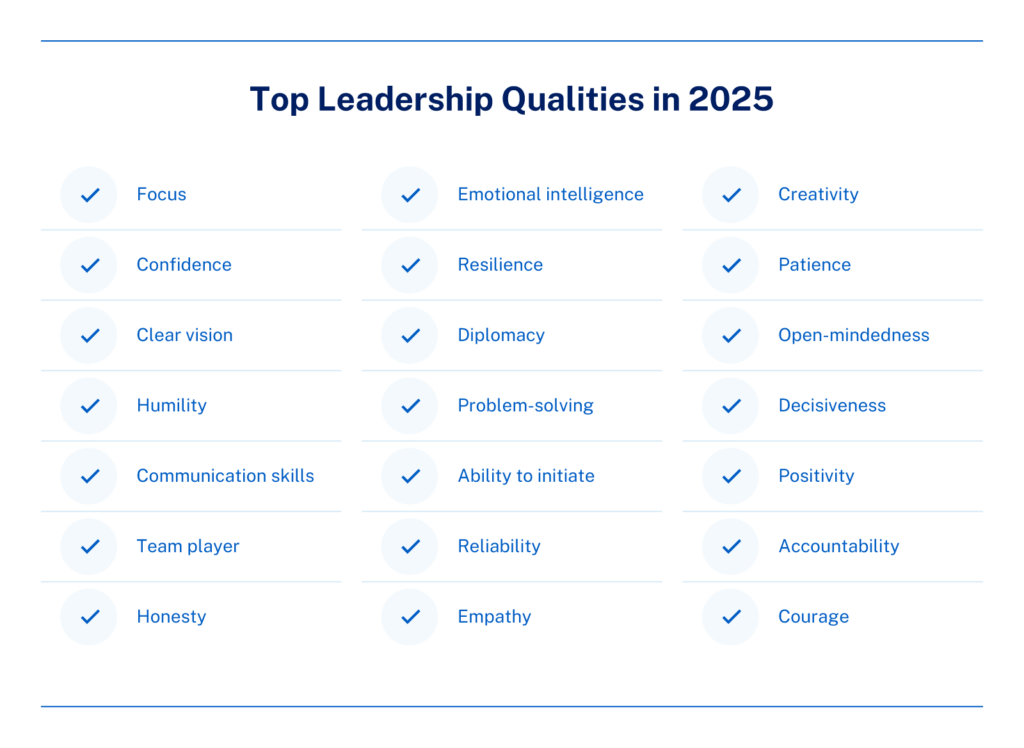The 21 most sought-after leadership qualities in
Businesses are in constant search of top talent with strong leadership qualities.
The best executive development programs go beyond traditional classroom education, blending academic learning with real-world applications to cultivate effective leaders.
Organizations expect leaders to be industry experts while also embodying the right mix of leadership styles to fit company culture and drive success. The bar for leadership is constantly rising, and executives must refine their skills to stand out.
This article highlights 21 leadership qualities that businesses value most in today’s dynamic environment.
- Focus
- Confidence
- Clear vision
- Humility
- Communication skills
- Team player
- Honesty
- Creativity
- Patience
- Open-mindedness
- Decisiveness
- Positivity
- Accountability
- Courage
- Emotional intelligence
- Resilience
- Diplomacy
- Problem-solving
- Ability to initiate
- Reliability
- Empathy
1. Focus
A strong leader stays focused despite distractions. Business leaders, like racehorses with blinkers, must maintain a laser-like focus on their objectives to navigate daily challenges effectively. Staying on track helps ensure progress toward organizational goals, even when unexpected challenges arise. An important leadership quality is the ability to cut through distractions and maintain clarity in decision-making.
Practical Tips:
- Plan ahead. Set up your priorities the night before to ensure a structured start to the day.
- Stay flexible. Stick to your plan, but be prepared to adjust for unexpected tasks.
- Prioritize. Start with quick wins to build momentum and create a sense of accomplishment.
- Recharge. Take short breaks to maintain energy and sustain concentration.
- Change your environment. A fresh setting can improve focus and enhance productivity.
2. Confidence
A confident leader instills trust in their team and makes decisive choices. Confidence is as crucial as competence in a leadership role. A true leader understands that self-assurance influences how others perceive their abilities and decisions. Confidence allows leaders to take responsibility, inspire their team, and drive results without hesitation.
Practical tips:
- Take smart risks. Assess situations carefully, but don’t fear failure, as it fosters growth.
- Surround yourself with positivity. Engage with supportive colleagues and mentors who reinforce your strengths.
- Practice. Apply leadership strategies consistently to refine your approach and build self-assurance.
3. Clear vision
A leader must understand their purpose, know the facts, and recognize their impact. Having a clear vision enables strong planning and communication, ensuring that leadership decisions align with common goals. Leaders with a well-defined vision can inspire confidence in their teams, set clear expectations, and guide organizations toward long-term success.
Strong leadership traits include the ability to think strategically, communicate effectively, and adapt to changing circumstances. Without a clear vision, leaders risk making reactive decisions rather than proactive, goal-oriented ones.
Practical tips:
- Define your career story. Identify your strengths and motivators to establish a leadership path that reflects your values and ambitions.
- Find a mentor. Work with a career coach or senior colleague to gain insight, refine your leadership style, and expand your professional network.
- Write a statement of purpose. Clearly articulate your leadership philosophy to reinforce decision-making and align your vision with your team’s common goals.
4. Humility
Great leaders acknowledge that they don’t have all the answers. Intellectual humility fosters learning and collaboration, enabling leaders to grow and adapt. By recognizing their own limitations, leaders can build stronger teams, encourage innovation, and create an environment where diverse perspectives are valued.
A humble leader actively works to overcome biases, making better-informed and fairer decisions. Leaders who embrace humility also focus on empowering their teams by providing opportunities for growth, learning, and leadership development.
Practical tip:
- Seek feedback. Use 360-degree reviews to identify growth areas and improve leadership effectiveness.
- Empower your team. Encourage independence and stewardship by trusting team members with key responsibilities. This approach not only builds confidence in employees but also strengthens overall team performance.
- Acknowledge mistakes. Openly admitting when you are wrong sets an example for accountability and continuous improvement.
5. Communication skills
Leadership requires effective communication across multiple platforms. In today’s fast-paced and digital-driven world, good communication is essential for maintaining productivity and collaboration. Leaders must develop strong communication skills to convey their message clearly, motivate their team, and foster meaningful connections. Effective communication goes beyond just speaking — it involves active listening, understanding different communication styles, and adapting to various audiences.
Practical tips:
- Be clear and concise. State objectives and key takeaways upfront to avoid misunderstandings and ensure alignment.
- Use modern tools. Adapt to evolving communication methods, such as video conferencing, messaging apps, and collaboration platforms, to facilitate effective communication across remote and in-person teams.
- Encourage two-way communication. Foster an open dialogue where team members feel comfortable sharing their ideas and concerns.
6. Team player
Leaders should actively participate in their teams rather than remain detached. Being a team player is essential for fostering trust, encouraging collaboration, and driving collective success. Leaders who engage with their team members create a supportive environment where everyone feels valued and motivated to contribute. By working toward common goals alongside their team, leaders demonstrate commitment and reinforce a culture of accountability and shared achievement.
Practical tips:
- Conduct regular team huddles. Brief check-ins help align goals and expectations, keeping team members informed, engaged, and focused on achieving common goals.
- Lead by example. Show your commitment by taking on tasks, supporting others, and actively participating in team efforts.
- Recognize contributions. Acknowledge and appreciate the efforts of team members to boost morale and foster a culture of collaboration.
7. Honesty
Trust is built on honesty and consistency. Leaders who prioritize transparency create an environment where team members feel valued and secure. Open communication fosters accessibility, allowing employees to express concerns, ask questions, and contribute more effectively. By addressing challenges with integrity, leaders build trust and strengthen their organization’s culture.
Practical tip:
- Set clear expectations. Communicate goals, responsibilities, and timelines to reduce misunderstandings and ensure alignment.
- Address difficult topics with transparency. Be open about challenges while maintaining confidentiality where necessary.
- Foster an open-door policy. Encourage team members to voice their thoughts and concerns without fear of judgment.
8. Creativity
Successful leaders think like innovators, continuously seeking improvement and embracing new ideas. A growth mindset enables leaders to adapt to changes and find creative solutions to challenges. Encouraging continuous learning and experimentation helps businesses stay ahead in competitive markets.
Practical tips:
- Encourage brainstorming. Collaborate with diverse groups to generate fresh ideas and unique solutions.
- Attend workshops. Expand your knowledge and network by engaging in professional development opportunities.
- Foster a culture of experimentation. Allow teams to test new ideas and learn from failures without fear of repercussions.
9. Patience
Resilience and patience help leaders navigate complex business dynamics. Staying calm under pressure ensures steady progress even in difficult situations. A leader’s adaptability in challenging moments inspires confidence and helps teams remain focused on solutions rather than setbacks.
Practical tips:
- Practice mindfulness. Develop self-awareness to manage stress effectively and make thoughtful decisions.
- Adopt a long-term perspective. Focus on gradual improvement rather than expecting immediate results.
- Stay composed under pressure. Lead with a level head to prevent emotions from driving decisions.
10. Open-mindedness
A great leader listens to different perspectives and embraces change. Being receptive to new ideas, feedback, and alternative approaches leads to innovation and better decision-making. Leaders who engage in thoughtful assessments before acting become better leaders by considering diverse viewpoints.
Practical tips:
- Respond, don’t react. Assess situations before making decisions to avoid impulsive choices.
- Seek diverse perspectives. Encourage input from various backgrounds to enhance problem-solving and innovation.
- Challenge your own biases. Stay open to new viewpoints and be willing to adjust your stance when necessary.
11. Decisiveness
Leaders must make informed decisions and stand by them. Strong decision-making skills allow leaders to weigh risks, consider stakeholders, and act with confidence. Indecisiveness can create confusion, delay progress, and erode trust in leadership.
Practical tips:
- Trust your judgment. Weigh options carefully and take calculated risks when necessary.
- Gather relevant information. Base decisions on data, insights, and stakeholder input.
- Commit to action. Once a decision is made, move forward with confidence and clarity.
12. Positivity
A positive work environment improves productivity and engagement. Leaders who maintain a positive attitude set the tone for their teams, fostering motivation and collaboration. Small gestures of appreciation and an uplifting atmosphere can lead to positive change, improving morale and overall team performance.
Practical tips:
- Encourage fun. Small activities like trivia games or celebrations boost morale and team bonding.
- Recognize achievements. Acknowledge team members’ efforts to reinforce motivation and a supportive culture.
- Model optimism. Approach challenges with confidence and a solutions-focused mindset.

13. Accountability
Leaders take responsibility for both successes and setbacks. True leadership means owning decisions, learning from mistakes, and setting an example for accountability. In a leadership position, it is crucial to balance responsibility while knowing when to delegate tasks effectively to ensure efficiency and team growth.
Practical tips:
- Hold regular one-on-one sessions. Address performance proactively and offer support for improvement.
- Set clear expectations. Define roles and responsibilities to ensure accountability at all levels.
- Lead by example. Demonstrate reliability and integrity in your actions.
14. Courage
Leading requires stepping outside your comfort zone and making tough calls. Great leaders embrace challenges, take risks, and face uncertainty with confidence. Courageous leadership encourages professional development, inspiring teams to push their limits and innovate.
Practical tips:
- Set high standards. Challenge yourself and your team to exceed expectations and achieve excellence.
- Make tough decisions. Face difficult choices head-on, even when they are unpopular.
- Advocate for change. Speak up for necessary improvements and support bold initiatives.
15. Emotional intelligence
Self-awareness and empathy enhance leadership effectiveness. Leaders with high emotional intelligence can navigate interpersonal relationships with sensitivity and build trust within their teams. Empathetic leaders foster stronger connections and create a culture of understanding and collaboration through self-awareness and active listening.
Practical tips:
- Recognize emotional patterns. Identify and manage your triggers to respond thoughtfully rather than react impulsively.
- Practice active listening. Give full attention to team members to understand their concerns and perspectives.
- Cultivate empathy. Acknowledge different emotions and respond with compassion and fairness.
16. Resilience
Strong leaders adapt to adversity and remain steady under pressure. The ability to recover from setbacks defines effective leaders and sets the foundation for long-term success. Strong leaders view challenges as learning opportunities, using resilience to guide their teams through uncertainty.
Practical tips:
- Schedule quiet time. Start your day with reflection to stay grounded and focused.
- Develop coping strategies. Build stress-management techniques to maintain clarity during high-pressure situations.
- Stay solution-oriented. Focus on progress and adaptability rather than dwelling on setbacks.
17. Diplomacy
Effective leaders negotiate solutions that benefit all stakeholders. A diplomatic approach strengthens relationships and fosters mutual understanding in the workplace. Adapting your leadership style to accommodate different perspectives promotes transformational leadership, encouraging growth and positive change.
Practical tips:
- Be well-prepared. Gather facts before discussions to present well-informed solutions.
- Practice neutrality. Stay objective in conflicts to find fair resolutions.
- Communicate with tact. Address concerns respectfully to maintain professional relationships.
18. Problem-solving
Great leaders anticipate challenges and devise solutions. Strong problem-solving skills are among the key competencies that enable leaders to make informed decisions and navigate complex situations. Leaders who approach challenges with a proactive mindset help their teams stay agile and resilient in the face of uncertainty.
Practical tips:
- Keep an idea notebook. Document insights and innovative solutions for future reference and implementation.
- Break problems into steps. Analyze issues methodically to identify the root cause and develop effective solutions.
- Encourage team input. Leverage diverse perspectives to enhance problem-solving strategies and decision-making.
19. Ability to initiate
Initiative distinguishes extraordinary leaders from the rest. Taking action without waiting for direction is a critical component of leadership development, helping successful leaders drive progress and innovation. Leaders who take the lead on new ideas inspire confidence and create a culture of forward-thinking problem-solving.
Practical tips:
- Invest in self-development. Stay updated with industry trends and continuously expand your skills.
- Take ownership of opportunities. Identify areas for improvement and proactively implement solutions.
- Encourage a culture of initiative. Motivate team members to take responsibility and lead projects with confidence.
20. Reliability
Dependable leaders inspire confidence in their teams. Being trustworthy and consistent are essential leadership qualities that set the foundation for a strong and effective team dynamic. The best leaders follow through on commitments and create a stable environment where employees feel secure and supported.
Practical tips:
- Follow up. Keep commitments and communicate consistently to build trust.
- Be punctual and prepared. Show up on time and ensure you are ready for meetings, projects, and responsibilities.
- Set realistic expectations. Be honest about what you can deliver, and always follow through.
21. Empathy
Understanding team members’ perspectives fosters a collaborative culture. Leaders who practice active listening and demonstrate empathy create stronger relationships and enhance employee engagement. When employees feel heard and valued, they are more motivated, productive, and committed to the organization’s success.
Practical tips:
- Actively listen. Pay attention to both verbal and non-verbal cues to fully understand team members’ concerns.
- Acknowledge emotions. Validate employees’ feelings and show genuine concern for their well-being.
- Adapt communication styles. Tailor your approach to different individuals to foster inclusivity and support.

Elevate your leadership potential
Great leadership is built on a foundation of essential qualities, from confidence and clear vision to emotional intelligence and resilience. By cultivating these traits, leaders can inspire their teams, drive innovation, and navigate challenges with confidence. Leadership is not about a title — it’s about action, accountability, and continuous growth. The best leaders never stop learning; they seek feedback, refine their skills, and embrace new opportunities for development.
Whether you’re leading a team, a department, or an entire organization, these qualities will help you maximize your influence and create a lasting impact. The journey to great leadership begins with self-awareness, strategic decision-making, and the willingness to evolve.
IMD’s “Leadership Essentials” program is designed to help you excel in your current or next leadership role. You’ll gain valuable insights into your leadership style, strengths, and areas for growth. Expert coaching will help you navigate challenges and enhance your ability to influence and manage others effectively. The program equips you with practical skills to foster innovation, build high-performance teams, and handle difficult conversations with confidence. By the end, you’ll be prepared to lead with impact and drive meaningful change in your organization.
Stay up to date 💌
Join the IMD Community.
Stay informed with our latest insights on leadership, strategy, digital transformation and more. Explore fresh perspectives from IMD business school to help you navigate today’s complex business landscape.




